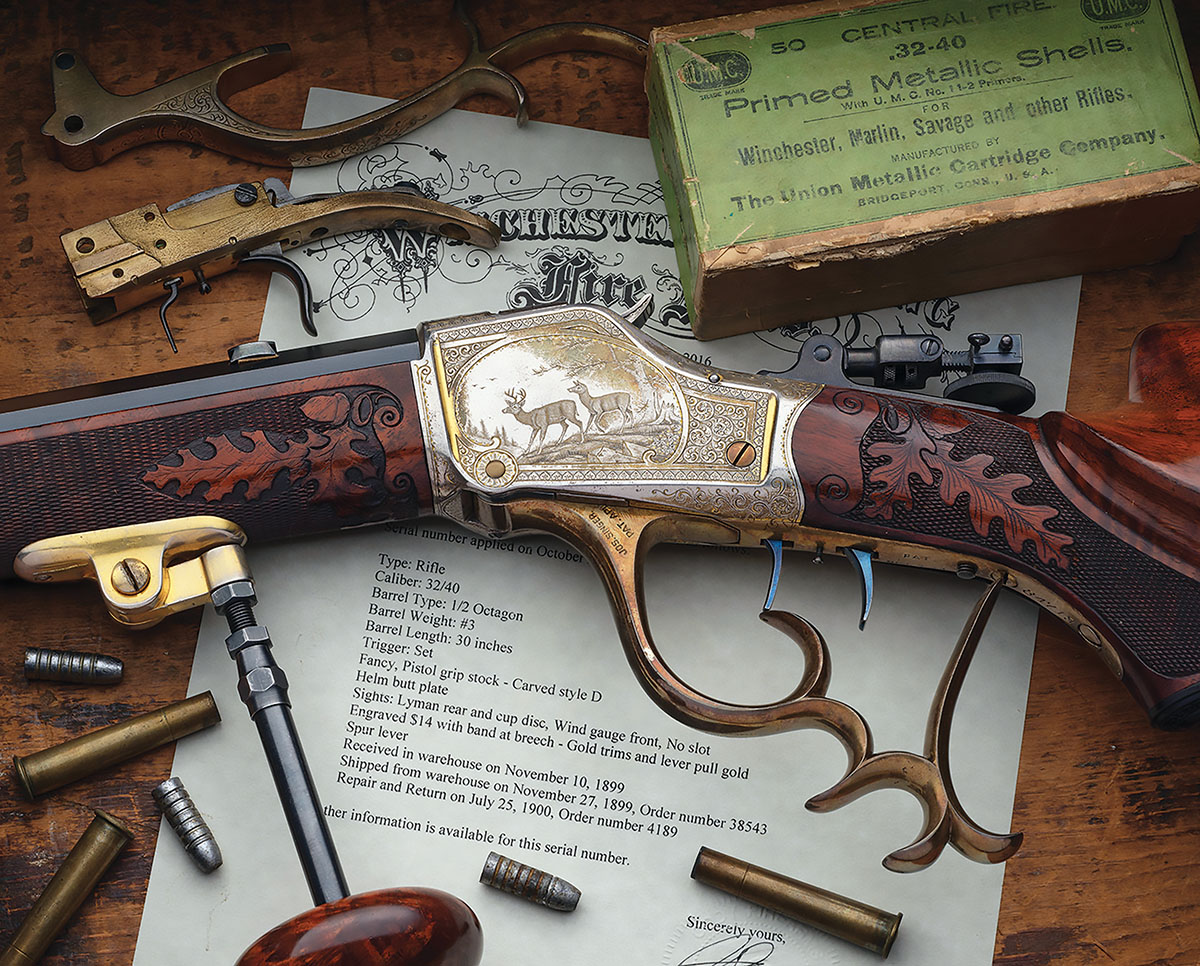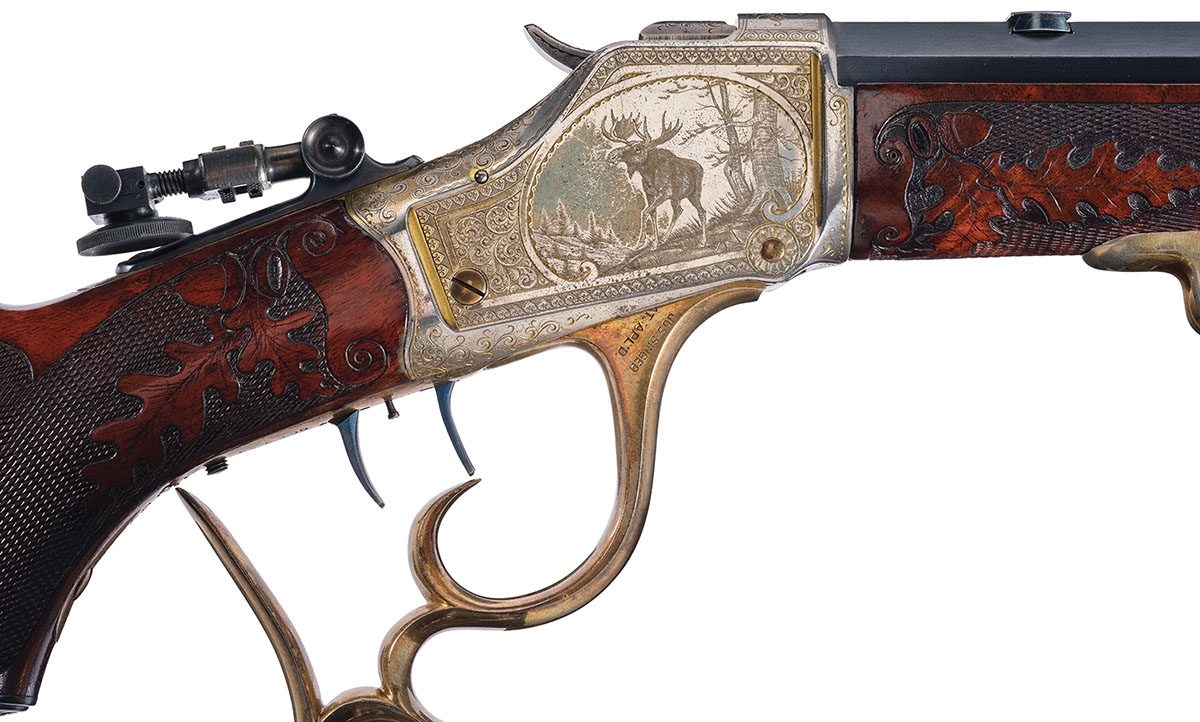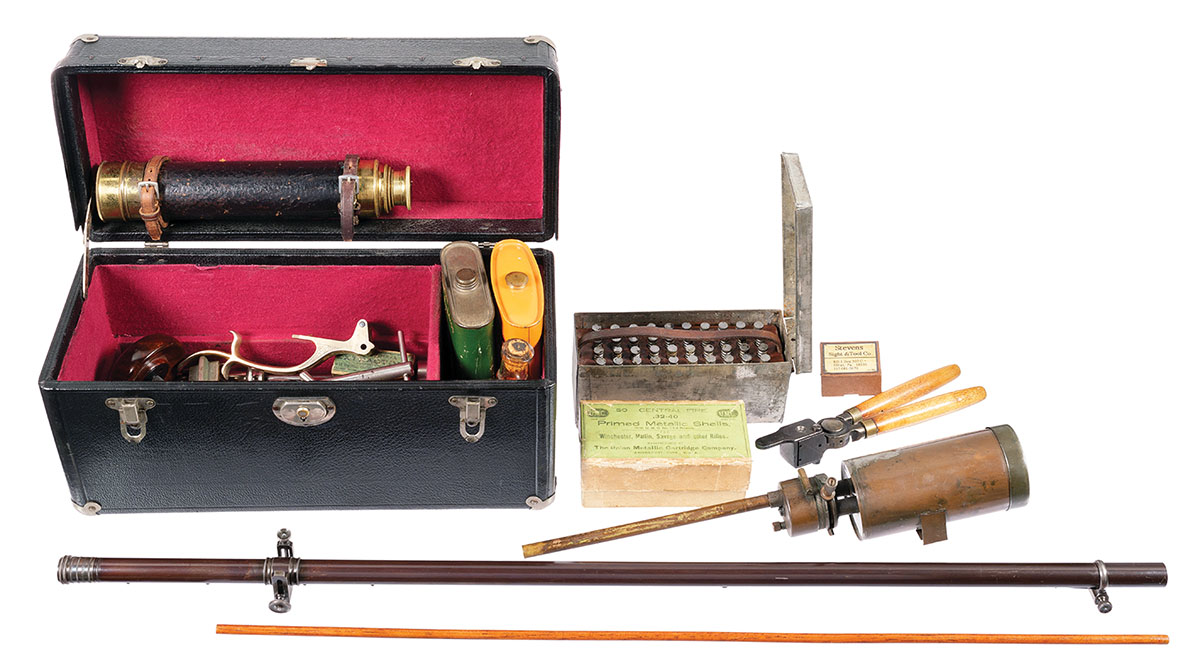In Range
High Flying High Wall
column By: Terry Wieland | April, 25

It may or may not be a record – $164,500 for a Winchester High Wall – but it’s certainly an unheard-of price for an auction lot that includes a box of assorted reloading tools.
The rifle in question was lot number 1018 in Rock Island’s premier auction in December, 2024. Billed as “Harry Pope’s Special Order Winchester 1885 Schuetzen Rifle,” it was a full-dress Schützen 32-40, delivered to Pope in 1899 and modified a year later, adding a Pope barrel, special lever, a different set trigger, tang sight and riflescope.
Harry Pope owned the rifle until 1933, when he sold it, along with a shooting box containing various loading equipment and accoutrements. Since then, it’s had a well-documented career, gracing several prominent collections.
What made the rifle likely to bring big bucks is that it appealed to four distinct sub-strata of collectors: Winchester lovers, obviously; engraving afiçionados (it’s believed to have been engraved by John Ulrich); admirers of Harry Pope; and, finally, the rest of us run-of-the-mill Schützen devotees. Rock Island estimated the rifle would bring $120,000 to $190,000, and they were right.

Just as an aside, the Pope high wall was not the main jewel in the auction. There was a set of three Purdey over/under 28-gauge shotguns ($381,875) and the very first Boss & Co. over/under 410, built circa 1938, which netted $352,500. For the record, the auction as a whole brought in $22.6 million, which suggests the gun-collecting market in the U.S. is alive, well and willing to spend.
The Pope rifle was accompanied by a whole passel of bits and pieces, including the shooting box with a brass and leather spotting scope cradled in the lid, a riflescope, the original set trigger and lever which had been replaced in 1900, a Pope powder measure, two cans of powder, some bullets and cartridge cases. The box has a lower compartment which contains “reloading tools,” which are not listed individually, but the photos show a bullet seater and bullet mould, among other things.
These are of interest because Harry Pope also manufactured tools to accompany rifles he barreled. Never a man to make do with a piece of equipment he found wanting, Pope would make bullet moulds, lubrication and sizing tools, powder measures, bullet seaters – you name it. And, of course, there was the false muzzle; Pope was big on seating bullets from the muzzle long after breech-loading cartridges became standard.
Twenty years ago, when I acquired my first 32-40 and was scouring eBay for moulds, I came across one for a 182-grain, .32-caliber bullet which had been made by Harry Pope. I was interested, but not to the tune of $650, which it eventually sold for; at that time, a similar Lyman or Ideal mould in usable condition brought maybe a hundred bucks.
The collecting of loading tools is an admittedly arcane area of the gun-collecting universe, and it helps considerably if a particular tool can be connected to a famous name.
Also in the Rock Island auction was a Walker Colt, one of the most sought-after of all American firearms. The revolver, one of the first 100 guns manufactured and sent to Capt. Samuel Walker’s ‘C’ Company of Texas volunteers, brought $199,750. Sold separately were a Walker Colt powder flask and bullet mould. The powder flask realized $32,313 (!) while the single-cavity bullet mould brought $9,988.
It’s not unusual for a Schützen rifle to be accompanied by a mould, a handful of bullets and maybe a bullet seater. Unless there’s a name connection, however, these do not seem to add anything to the value – in other words, the rifle would command the same price even if they were not there.
Years ago, I had a conversation with a gun dealer who was prominent in trading vintage English doubles, often in cases, accompanied by original cleaning tools and accoutrements which the flossy London companies put together for their clients. This gentleman was explaining to me how he could sell all those bits individually and make a lot more money. I was appalled at the thought. Separate items that had been together since birth? But, being a gun dealer who would fleece a widow without a second thought, such concerns did not matter to him.
In fairness, another dealer, equally prominent at the time, said that he would never think of doing such a thing. It would, he said, “simply be wrong.”
I expect that whoever owned (or now owns) the Harry Pope high wall would not do it either, because that rifle and its bits are now part of history.
Maybe I go too far in this.
In 2004, I acquired an E.M. Reilly side-by-side shotgun, made in the 1890s, that was in dreadful shape. Two years and several thousand dollars later, it was fully restored. It had come in a Brady case with an extra set of barrels, assorted cleaning utensils, a tiny, dented oil can and one snap cap. The Brady case was a total loss, and the jag and Turk’s head did not fit any wooden cleaning rod I could find. I obtained a two-barrel-set hard case from Tony Galazan to house the gun, and added a new rod and accoutrements, but I kept all the original stuff, useless or not, and it’s tucked in there with the Reilly. I just couldn’t bring myself to separate them. Will posterity thank me? Probably not, but at least I can live with myself.
A funny thing, during Harry Pope’s lifetime there were two or three other barrel makers who were considered every bit as good as he was – George Schoyen being the most obvious – but I’ve seen Schoyen rifles and loading equipment come up for sale and command nowhere near what Pope stuff does.

I am not about to offer an opinion on the relative quality of Pope versus Schoyen barrels, but C.W. Rowland, an expert marksman of the time, stated in print that he saw no difference in accuracy, and he had staged some side-by-side comparisons.
One difference is, however, that Pope had a major journalistic supporter, his good friend Lucian Cary, who wrote about him in everything from True – The Man’s Magazine to The Saturday Evening Post. Many of Cary’s articles were reprinted in Gun Digest over the years, as well as being anthologized. Schoyen, a very retiring man, had no such cheerleaders.
This is not to say Pope did not deserve the adulation. I’m sure he did. But it’s funny how things reverberate down through the years, and are reflected in collector values a century later.
One note I should make at this point: I’ve seen guns and equipment come up for sale, touted as having belonged to this gun writer or that one, often accompanied by a magazine or a book.
Added value as a result? Exactly nothing, as far as I can see, or nothing worth mentioning.
Lot 1018 included a 1935 photo of Harry Pope holding a high wall he built for Lucian Cary, who was standing behind him in the photo. As a Cary fan since I read “Madman of Gaylord’s Corner” in the 1967 Gun Digest – which, incidentally, was about Harry Pope in his fictionalized guise as J.M. Pyne – I’m disappointed how often, when I mention Cary’s name, I have to explain who he was, and when and what his contribution was.
As gun editor of True – The Man’s Magazine, Lucian Cary was a big name, and published annual anthologies of his gun articles through the 1950s. Some have been gathered into a more recent anthology (J.M. Pyne Stories & Selected Writings, Guy Lautard, 1991) which sold well, sold out and commanded big bucks, for a while. It’s now back in print and, at $29.95, is a bargain for every rifle lover.
Had a copy been included in the auction with the Pope high wall, however, I doubt it would have added a penny to the selling price even though I’m certain Cary’s stories helped make Pope famous, and added to the value of the rifle itself. Ah, well. That’s gun writing.


